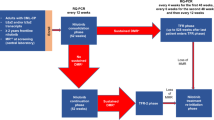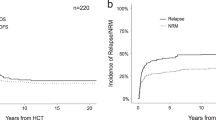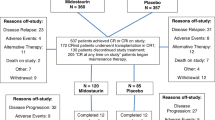Abstract
Less-intense remission induction regimens for adults with newly diagnosed acute myeloid leukemia (AML) aim to reduce treatment-related mortality (TRM), here defined as death within 4 weeks after starting induction therapy. This assumes that TRM rates are similar to the 15–20% observed 20 years ago. Herein we test this assumption. We examined TRM rates in 1409 patients treated on SWOG (Southwest Oncology Group) trials and 1942 patients treated at MD Anderson (MDA) from 1991 to 2009. Eighty-eight percent of SWOG patients received ‘3+7’ or regimens of similar intensity while 92% of the MDA patients received ara-C at 1.5–2.0 g/m2 daily × 3–5 days+other cytotoxic agents. We examined the relationship between time and TRM rates after accounting for other covariates. TRM rates between 1991 and 2009 decreased from 18–3% in SWOG and 16–4% at MDA. Multivariate analyses showed a significant decrease in TRM over time (P=0.001). The decrease in TRM was not limited to younger patients, those with a better performance status or a lower white blood cell count. Though our observations are limited to patients treated with intensive therapy at SWOG institutions and MDA, the decrease in TRM with time emphasizes the problem with historical controls and could be considered when selecting AML induction therapy.
This is a preview of subscription content, access via your institution
Access options
Subscribe to this journal
Receive 12 print issues and online access
$259.00 per year
only $21.58 per issue
Buy this article
- Purchase on Springer Link
- Instant access to full article PDF
Prices may be subject to local taxes which are calculated during checkout
Similar content being viewed by others
References
Appelbaum F, Gundacker H, Head D, Slovak M, Willman C, Godwin J et al. Age and acute myeloid leukemia. Blood 2006; 107: 3481–3485.
Walter R, Othus M, Borthakur G, Ravandi F, Cortes J, Pierce S et al. Prediction of early death after induction therapy for newly diagnosed acute myeloid leukemia with pretreatment risk scores: a novel paradigm for treatment assignment. J Clin Oncol 2011; 29: 4417–4423.
Estey E, Smith TL, Keating MJ, McCredie KB, Gehan EA, Freireich EJ . Prediction of survival during induction therapy in patients with newly diagnosed acute myeloblastic leukemia. Leukemia 1989; 3: 257–263.
Burnett AK, Milligan D, Prentice AG, Goldstone AH, McMullin MF, Hills RK et al. A comparison of low-dose cytarabine and hydroxyurea with or without all-trans retinoic acid for acute myeloid leukemia and high-risk myelodysplastic syndrome in patients not considered fit for intensive treatment. Cancer 2007; 109: 1114–1124.
Fenaux P, Mufti G, Hellström-Lindberg E, Santini V, Gattermann N, Germing U et al. Azacitidine prolongs overall survival compared with conventional care regimens in elderly patients with low bone marrow blast count acute myeloid leukemia. J Clin Oncol 2010; 28: 562–569.
Platzbecker U, Germing U . Combination of azacitidine and lenalidomide in myelodysplastic syndromes or acute myeloid Leukemia—a wise liaison?". Leukemia 2013; e-pub ahead of print 6 May 2013; doi: 10.1038/leu.2013.140.
Pollyea D, Kohrt H, Gallegos L, Figueroa ME, Abdel-Wahab O, Zhang B et al. Safety, efficacy and biological predictors of response to sequential azacitidine and lenalidomide for elderly patients with acute myeloid leukemia. Leukemia 2011; 26: 893–901.
Kantarjian H, Thomas X, Dmoszynska A, Wierzbowska A, Mazur G, Mayer J et al. Multicenter, randomized, open-label, phase III trial of decitabine versus patient choice, with physician advice, of either supportive care or low-dose cytarabine for the treatment of older patients with newly diagnosed acute myeloid leukemia. J Clin Oncol 2012; 30: 2670–2677.
Quintas-Cardama A, Santos F, Garcia-Manero G . Histone deacetylase inhibitors for the treatment of myelodysplastic syndrome and acute myeloid leukemia. Leukemia 2010; 25: 226–235.
Gooley TA, Chien JW, Pergam SA, Hingorani S, Sorror ML, Boeckh M et al. Reduced mortality after allogeneic hematopoietic-cell transplantation. N Engl J Med 2010; 363: 2091–2101.
Walter R, Othus M, Borthakur G, Ravandi F, Cortes J, Pierce S et al. Quantitative effect of age in predicting empirically-defined treatment-related mortality and resistance in newly diagnosed AML: case against age alone as primary determinant of treatment assignment. Blood 2010; 116: 2191 (ASH abstract # 2191).
Baden L . Prevention and therapy of fungal infections in bone marrow transplantation. Leukemia 2003; 17: 1038–1041.
Aperis G, Alivanis P . Posaconazole: a new antifungal weapon. Rev Recent Clin Trials 2011; 3: 204–219.
Pagano L, Caira M, Candoni A, Aversa F, Castagnola C, Caramatti C et alfor the SEIFEM Group. Evaluation of the practice of antifungal prophylaxis use in patients with newly diagnosed acute myeloid leukemia: results from the SEIFEM 2010-B Registry. Clin Infect Dis 2012; 55: 1515–1521.
Walsh T, Teppler H, Donowitz G, Maertens J, Baden L, Dmoszynska A et al. Caspofungin versus liposomal amphotericin B for empirical antifungal therapy in patients with persistent fever and neutropenia. N Engl J Med 2004; 351: 1391–1402.
Author information
Authors and Affiliations
Corresponding author
Ethics declarations
Competing interests
The authors declare no conflict of interest.
Additional information
Author contributions
MO: analyzed and interpreted data, performed statistical analysis, principal writer and corresponding author; HK, SP, FR, JG, JC, HE, SF: data collection, data interpretation and manuscript writing; SP: data collection and manuscript writing; FRA: analyzed and interpreted data, aided in writing and administrative support; EHE: designed research, analyzed and interpreted data and manuscript writing.
Rights and permissions
About this article
Cite this article
Othus, M., Kantarjian, H., Petersdorf, S. et al. Declining rates of treatment-related mortality in patients with newly diagnosed AML given ‘intense’ induction regimens: a report from SWOG and MD Anderson. Leukemia 28, 289–292 (2014). https://doi.org/10.1038/leu.2013.176
Received:
Revised:
Accepted:
Published:
Issue Date:
DOI: https://doi.org/10.1038/leu.2013.176
Keywords
This article is cited by
-
Impact of treatment intensity on infectious complications in patients with acute myeloid leukemia
Journal of Cancer Research and Clinical Oncology (2023)
-
Characteristics and outcomes of patients with acute myeloid leukemia admitted to intensive care unit with acute respiratory failure: a post-hoc analysis of a prospective multicenter study
Annals of Intensive Care (2023)
-
ELN 2017 classification significantly impacts the risk of early death in acute myeloid leukemia patients receiving intensive induction chemotherapy
Annals of Hematology (2022)
-
Trends in Inpatient Chemotherapy Hospitalizations, Cost and Mortality for Patients with Acute Leukemias and Myeloma
Clinical Hematology International (2022)
-
A real-life overview of a hematopoietic cell transplant program throughout a four-year period, including prospective registry, exclusion causes and final donor selection
Bone Marrow Transplantation (2022)



